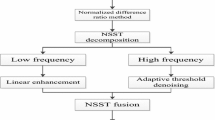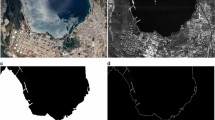Abstract
The squall line is a linear mesoscale convective system often seen in summer, which could bring severe disasters, such as thunderstorms, hails and tornadoes. So, the identification and forecast of squall lines are the important and difficult problems in operational weather nowcasting. In this paper, based on weather radar data an automatic identifying method of the squall line is presented. After image de-noising, extraction of the central axis of strong echo areas, and the Hough Transform, the spatial form and intensity variation characteristics of the reflectivity factors in the radar image are analyzed. On this basis, the automatic identification of squall line could be achieved. This method can overcome the adverse effects of the discontinuity of strong echo areas on the automatic identification of squall lines. The verification of squall line cases shows that the successful identification rate of squall lines is over 95%. Especially, when the boundary of the strong echo area is clear and is in a straight line or minor arc, the identification rate is higher. Overall, this new method has realized the automatic identification of squall lines on radar images, which could greatly improve the accuracy and time-effectiveness of squall line identification, and could provide a solid basis for the automatic forecast of squall lines in operational weather nowcasting.







Similar content being viewed by others
References
Alajarmeh A, Zaidan AA (2018) A real-time framework for video Dehazing using bounded transmission and controlled Gaussian filter. Multimed Tools Appl 77:26315–26350. https://doi.org/10.1007/s11042-018-5861-4
Bala K, Paul S, Ghosh M (2019) Thunderstorm prediction using soft computing and wavelet. In: Proceeding of the Second International Conference on Microelectronics, Computing & Communication Systems (MCCS 2017). Springer, Singapore. https://doi.org/10.1007/978-981-10-8234-4_11
Bluestein HB, Marx GT, Jain MH (1987) Formation of mesoscale lines of precipitation: nonsevere squall lines in Oklahoma during the spring. Mon Weather Rev 115(11):2719–2727
Bryan GH, Knievel JC, Parker MD (2006) A multimodel assessment of RKW theory’s relevance to squall-line characteristics. Mon Weather Rev 134(10):2772–2792
Congedo F, Prodi F, Pasqualucci F, Trivellone G (2017) Polarimetric Doppler radar analysis of squall line systems crossing Salento peninsula. Meteorol Appl 24(3):338–348
Dixon M, Wiener G (1993) TITAN: thunderstorm identification, tracking, analysis and nowcasting—a radar-based methodology. J Atmos Ocean Tech 10:785–797
Duda R, Hart P (1972) Use of the Hough transformation to detect lines and curves in pictures. Comm of ACM 15(1):11
Gamache JF, Houze RA Jr (1982) Mesoscale air motions associated with a tropical squall line. Mon Weather Rev 110(2):118–135
Hou, Shumei, Min, Jinzhong, Diao, Xiuguang et al (2018) Analysis of echoes merging characteristics during squall line development process. Transactions of Atmospheric Sciences. https://doi.org/10.13878/j.cnki.dqkxxb.20171021004 (in Chinese)
Kamani MM, Farhat F, Wistar S, Wang JZ (2018) Skeleton matching with applications in severe weather detection. Appl Soft Comput 70:1154–1166
Kelly WE, Rand TW, Uckun S et al (2003) Image processing for hazard recognition in on-board weather radar. US Patent No 6:650,275
Leavers VF (1993) Which hough transform? CVGIP: Image understanding 58(2):250–264
Lee HY, Lee CH, Lee HK (2007) Geometrically invariant watermarking: synchronization through circular Hough transform. Multimed Tools Appl 34(3):337–353
Li Z, Li G, Liu L et al (2017) Optimal identification method of squall line and thunderstorm winds analysis. Plateau Meteorology 36(3):801–810 (in Chinese)
Liu P, Yu H, Cang S (2019) Adaptive neural network tracking control for underactuated systems with matched and mismatched disturbances. Nonlinear Dynamics 98:1447–1464. https://doi.org/10.1007/s11071-019-05170-8
Lu X, Wang W, Ma C et al (2019) See more, know more: unsupervised video object segmentation with co-attention Siamese networks. CVPR19 (pp. 3623-3632)
Lu X, Wang W, Shen J et al (2020) Learning video object segmentation from unlabeled videos. 2020 IEEE/CVF Conference on Computer Vision and Pattern Recognition (CVPR) (pp. 8960-8970)
Mafi M, Martin H, Cabrerizo M, Andrian J, Barreto A, Adjouadi M (2019) A comprehensive survey on impulse and Gaussian denoising filters for digital images. Signal Process 157:236–260. https://doi.org/10.1016/j.sigpro.2018.12.006
Maki M, Keenan TD, Sasaki Y, Nakamura K (2001) Characteristics of the raindrop size distribution in tropical continental squall lines observed in Darwin, Australia. J Appl Meteorol 40(8):1393–1412
Noor A, Zhao Y, Khan R, Wu L, Abdalla FYO (2020) Median filters combined with denoising convolutional neural network for Gaussian and impulse noises. Multimed Tools Appl 79:18553–18568. https://doi.org/10.1007/s11042-020-08657-4
Oliveira FP, Oyama MD (2020) Squall-line initiation over the northern coast of Brazil in march: observational features. Meteorol Appl 27. https://doi.org/10.1002/met.1799
Rotunno R, Klemp JB, Weisman ML (1988) A theory for strong, long-lived squall lines. J Atmos Sci 45(3):463–485
Schenkman AD, Xue M (2016) Bow-echo mesovortices: a review. Atmos Res 170:1–3
Sheng J (2019) Evolution and mechanism of a rare squall line in China of 2018. Meteor Mon 45(2):141–154 (in Chinese)
Sun SY (2018) Impact of assimilating surface and radar observations on forcasting of squall lines with a hybrid data assimilation method. Dissertation, Lanzhou University (in Chinese)
Sun L, Zhao C, Yan Z, Liu P, Duckett T, Stolkin R (2018) A novel weakly-supervised approach for RGB-D-based nuclear waste object detection. IEEE Sensors J 19:3487–3500. https://doi.org/10.1109/JSEN.2018.2888815
Tang Z, Yu H, Lu C, Liu P, Jin X (2019) Single-trial classification of different movements on one arm based on ERD/ERS and Corticomuscular coherence. IEEE Access 7:128185–128197. https://doi.org/10.1109/ACCESS.2019.2940034
Tang ZC, Li C, Wu JF, Liu PC, Cheng SW (2019) Classification of EEG-based single-trial motor imagery tasks using a B-CSP method for BCI. Front Inf Technol Electron Eng 20:1087–1098. https://doi.org/10.1631/FITEE.1800083
Trapp RJ, Weisman ML (2003) Low-level mesovortices within squall lines and bow echoes. Part II: their genesis and implications. Mon Weather Rev 131(11):2804–2823
Wang L, Wang H, Heng Z (2019) A rapid identification and warning method for severe weather via Doppler radar based on an improved TITAN algorithm. J Atmos Sol Terr Phys 193:105080. https://doi.org/10.1016/j.jastp.2019.105080
Wilks DS (2011) Statistical methods in the atmospheric sciences (Vol. 100). Academic press
Wu FF, Yu XD, Zhang ZG et al (2013) A study of the environmental conditions and radar echo characteristcis of the supercell-storms in northern Jiangsu. Acta Meteorologica Sinica 71(2):209–227 (in Chinese)
Wu RJ, Tao W, Zhou K et al (2019) General features of squall lines with disastrous gale in the Yangtze-Huaihe area. Meteor Mon 45(2):155–165 (in Chinese)
Ping Zhang, Yuanyuan Gui, Wenhui Li (2018) Radar echo characteristics of a strong squall line weather process. Jiangxi Science. https://doi.org/10.13990/j.issn1001-3679.2018.01.020 (in Chinese)
Acknowledgements
This work is financially supported by the National Natural Science Foundation of China (Grand No. 41805033) and the Jiangsu Province Industry-University-Research Cooperation Project of China (Grand No. BY2018010). We would like to acknowledge the National Demonstration Center for Experimental Atmospheric Science and Environmental Meteorology Education at Nanjing University of Information Science and Technology for providing experimental environment and meteorological observations. We thank Nanjing Hurricane Translation for reviewing the English language quality of this paper.
Author information
Authors and Affiliations
Corresponding author
Additional information
Publisher’s note
Springer Nature remains neutral with regard to jurisdictional claims in published maps and institutional affiliations.
Rights and permissions
About this article
Cite this article
Wang, X., Bian, Hx., Qian, Dl. et al. An automatic identifying method of the squall line based on Hough transform. Multimed Tools Appl 80, 18993–19009 (2021). https://doi.org/10.1007/s11042-021-10689-3
Received:
Revised:
Accepted:
Published:
Issue Date:
DOI: https://doi.org/10.1007/s11042-021-10689-3




